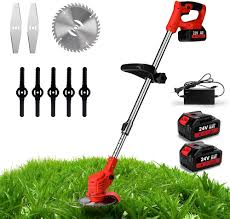Weed Eater, Maintaining a neat and tidy lawn requires more than just a lawnmower. For those tricky spots that your mower can’t reach—around trees, fences, and flower beds—a weed eater, also known as a string trimmer, is essential. Whether you’re dealing with overgrown grass, weeds, or thick brush, the right weed eater can make your yard work much easier and more efficient.
In this guide, we’ll break down everything you need to know about weed eaters, including the different types available, how to choose the right one for your needs, and tips for maintaining your tool to ensure it lasts for years.
What is a Weed Eater?
A weed eater, also referred to as a weed whacker or string trimmer, is a garden tool used to cut grass and weeds in areas that are hard to reach with a lawnmower. The tool uses a flexible monofilament line (the string) to slice through grass and light vegetation. Weed eaters are versatile and can be used for edging, trimming, and even clearing brush, depending on the model.
Types of Weed Eaters
Weed eaters come in three main varieties: gas-powered, electric (corded), and battery-powered (cordless). Each has its advantages and disadvantages, depending on the size of your lawn, your budget, and your personal preferences.
- Gas-Powered Weed Eaters:
- Advantages: Gas-powered weed eaters are known for their power and ability to handle large yards with thick vegetation. They are ideal for professional landscapers or those with large properties.
- Disadvantages: These models are generally heavier, noisier, and require more maintenance (such as refueling and oil changes). They also emit fumes, which can be a concern for environmentally conscious users.
- Electric Weed Eaters (Corded):
- Advantages: Corded electric weed eaters are lightweight, easy to start, and require minimal maintenance. They are an excellent option for small to medium-sized lawns and provide consistent power as long as they’re plugged in.
- Disadvantages: The major drawback is the cord. You’ll need an extension cord long enough to cover your yard, which can be a hassle to manage and limits your mobility.
- Battery-Powered Weed Eaters (Cordless):
- Advantages: Cordless weed eaters offer the convenience of a gas-powered model without the fumes, plus the lightweight design of an electric model without the cord. They are quiet, easy to maneuver, and ideal for medium-sized lawns.
- Disadvantages: The main downside is battery life. Depending on the model, you might only get 20-40 minutes of runtime before needing to recharge or swap out the battery.
Choosing the Right Weed Eater for Your Lawn
When choosing a weed eater, consider the size of your lawn, the type of vegetation you’ll be dealing with, and your comfort level with handling different tools.
- Small Lawns: If you have a small lawn with minimal obstacles, a corded electric or lightweight cordless weed eater is likely your best bet. These options are easy to use and maintain, making them perfect for simple yard work.
- Medium Lawns: For medium-sized lawns, a cordless weed eater is ideal. It provides the freedom to move around without worrying about a cord, and many models offer enough power and battery life to tackle a typical yard in one go.
- Large Lawns: If you’re dealing with a large property or tougher vegetation, a gas-powered weed eater might be necessary. The additional power and longer runtime make it easier to manage larger areas without interruptions.
Maintenance Tips for Your Weed Eater
To get the most out of your weed eater and ensure it lasts for years, regular maintenance is key. Here are some tips:
- Keep the Line Spool Clean: Grass and debris can accumulate around the spool, leading to tangles and uneven trimming. Clean the spool regularly to keep your trimmer working smoothly.
- Check the Line: The cutting line will wear down and break over time. Check it frequently and replace it as needed to ensure optimal cutting performance.
- Clean the Air Filter (Gas Models): Gas-powered models have air filters that can get clogged with dust and dirt. Clean or replace the air filter regularly to prevent engine problems.
- Battery Care (Cordless Models): For battery-powered weed eaters, make sure to charge the battery fully before use, and avoid leaving it in extreme temperatures to extend its lifespan.
- Store Properly: When the season is over, store your weed eater in a dry, cool place. For gas models, run the engine until it’s out of fuel to prevent the fuel from going stale in the tank.
Conclusion
A weed eater is a must-have tool for anyone looking to maintain a well-manicured lawn. By understanding the different types available and selecting the one that best suits your needs, you can make yard maintenance easier and more efficient. Regular care and maintenance will ensure your weed eater remains in good condition, providing reliable performance for years to come.
With the right weed eater in hand, tackling those hard-to-reach spots and keeping your lawn looking pristine is just a matter of time and technique. Happy trimming!
You Might Also Like These:



